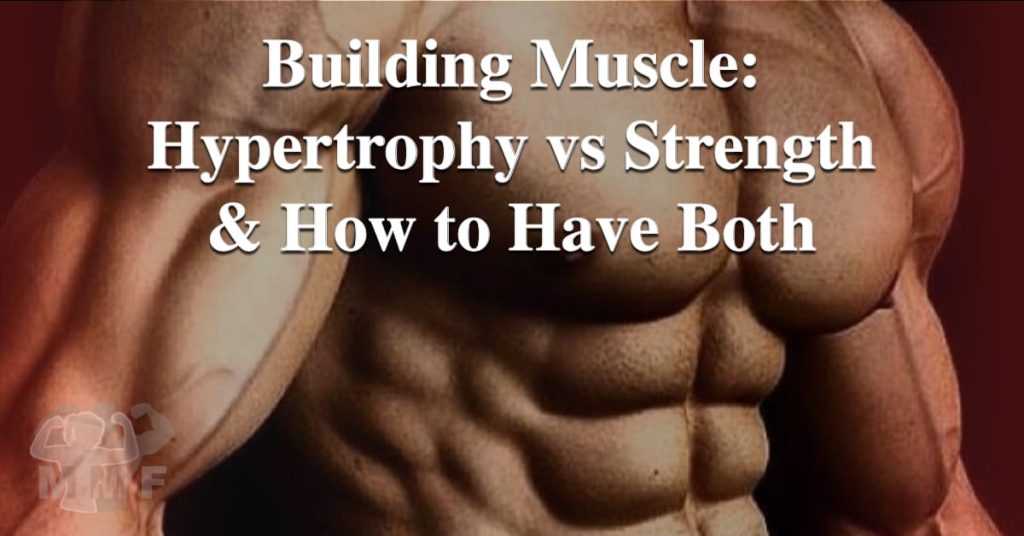When it comes to lifting weights, you may be asking what is the difference between hypertrophy (growth) and strength training. Or how do you train for both size and strength? Maybe you want to know how to increase strength but not the size or vice versa. These are really good questions and mean that you don’t want to waste your time at the gym. First, let’s look at how muscles grow: Hypertrophy.
Sarcoplasmic Hypertrophy vs Myofibrillar Hypertrophy
There are two main types of muscle hypertrophy they are Sarcoplasmic Hypertrophy and Myofibrillar Hypertrophy.
Sarcoplasmic Hypertrophy (Growing Muscle Size)
Sarcoplasmic Hypertrophy increases the size of your skeletal muscle fibers without any noticeable increase in strength. Specifically, the sarcoplasmic fluid, which can be mostly glycogen, in the muscle increases making the muscle larger. Sarcoplasmic Hypertrophy training can be “cosmetic,” such as in bodybuilding. Although many athletes also want to increase the size of their muscles, such as linemen in football. Increasing your muscles’ glycogen can also increase muscle endurance since glycogen is the energy your muscles use.

Myofibrillar Hypertrophy (Building Muscle Strength)
Myofibrillar Hypertrophy increases the size of your skeletal muscle fibers as well but by adding sarcomeres, the contractile elements of your muscles. You may be like many people who go to the gym and are performing workouts designed for Sarcoplasmic Hypertrophy but really are looking to get stronger. Unfortunately, if this is you, you are likely disappointed with your strength gains. Scientifically there are still some mysteries about how your muscles increase strength. Fortunately, even though the mechanism isn’t completely understood, how to activate strength gains is well-documented and repeatable.
Bodybuilding and Powerlifting
Looking at the far ends of the spectrum for weightlifting you have bodybuilding and powerlifting. If your goal is to win some bodybuilding competition, you know you are judged on the way you look, not by how much weight you can lift. In contrast, if you are working to win a powerlifting competition you win by how much weight you can lift regardless of how you look. But in both cases, you would want to perform workouts that focus on both size and strength.
Reps for Strength Training and Body Building Explained
Lifting Weights to Increase Size (Sarcoplasmic Hypertrophy)
When training for size you should use lower weight with slightly higher repetition. Don’t go so low that you are turning your weight training into a cardio workout. For example, you should lift a weight where your muscle failure occurs between 12 and 20 reps. You should only rest in between sets for a minute or two. Lifting for size is anaerobic, so you shouldn’t require full recovery in between sets. Additionally, you want to perform each exercise at a steady speed not explosive and not slow.
Lifting Weights to Build Strength (Myofibrillar Hypertrophy)
The method of increasing strength that has been found the most effective is called progressive overloading. Here you will lift left more weight and perform fewer repetitions. You will also increase the rest period between sets or you can even do a single set to failure. The goal is to fatigue the muscle fully and let it over-recover and get stronger. Each repetition should be done slowly for maximum effect, also known as increasing time under tension. You may need to rest seven or more days in between training the same muscle to ensure that they have fully recovered. If you have developed the habit of going to the gym frequently, the hardest thing for you to do maybe rest.
Comparing Lifting Routines For Size vs Strength
| Lifting For Size | Lifting for Strength | |
| Reps | 8-20 | 1-5 |
| Weight | 50-70% of 1RM | 70-90% of 1RM |
| Rest | 1-3 Minutes | 3-5 Minutes (or Single Set |
| Recovery | 4-7 Days | 7 or more Days |
Tips for Lifting For Both Size and Strength
Perform each set to technical failure
- Technical failure is when you can’t perform the exercise movement again with proper form. You may be able to squeeze out a few more reps, but not without cheating.
- Going to this near failure will fatiguing your muscle to your body the signal to build muscle.
- If you are training for speed or power, then going to failure can be counter productive.
The Amount of Weight is not as Important as Good Form
- If you find that you can perform the lift with good form then drop the weight. You also need to be lifting enough weight that it fully fatigues your target muscle.
Lifting Slowly Can Build Muscle Fast
- Lifting slow can increasing the time under tension and fatigue your muscles faster and build size more effectively. In contrast, if your goal is to build explosive power, you will need to practice explosive power while lifting.
Mix Up Your Routine
- The fastest way to plateau is to do the same workouts with the same lifts over an over again. You should change your training up regularly. If your goal is to build muscle size then every third week, lift for strength. If you goal is to develop strength then cycle in some hypertrophy training.
- It is also wise to change the lifts you are doing for a given muscle group. Never do the same lift, the same way for more than 3 weeks in a row without changing the variation of the exercise or do a different exercise for the same muscle group.
How to Build Both Strength and Mass
You need to change your workout routine to gain both strength and mass. You can combine strength training and muscle building into the same workout, but it will not be as effective. It is better to train for a few weeks increasing strength and then switch your workout to build mass. Additionally, if you switch your routine prior to reaching a plateau, you are likely to shock your system into not hitting that plateau. Instead of hitting that wall, you will continue to see gains in both strength and mass.
Share or Save This Article By Pinning This Image




Nice blog here! Additionally, your site loads so fast!
What web host are you using? Can I get your affiliate link to your host? I wish my site loaded up as quickly as yours lol.